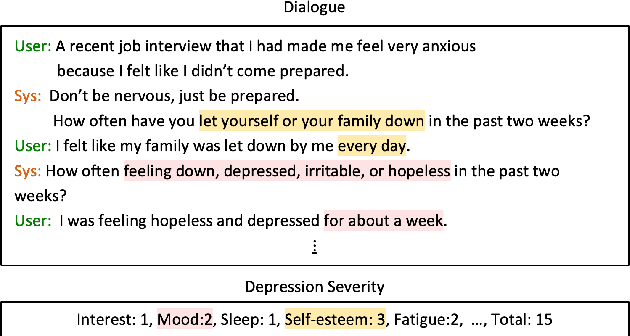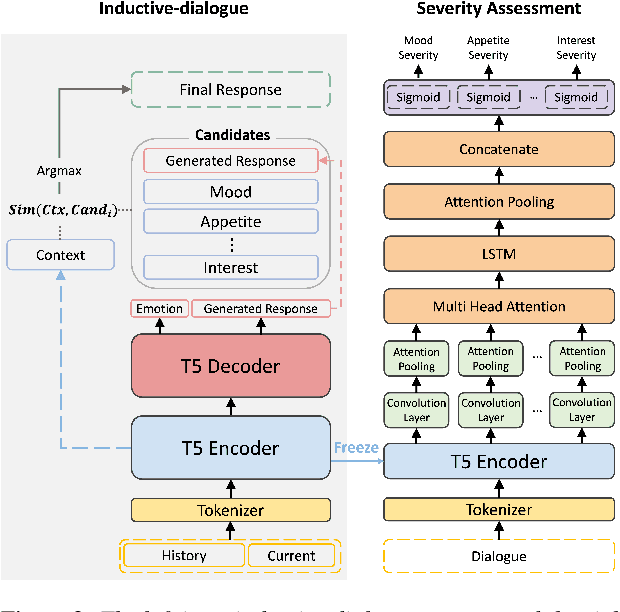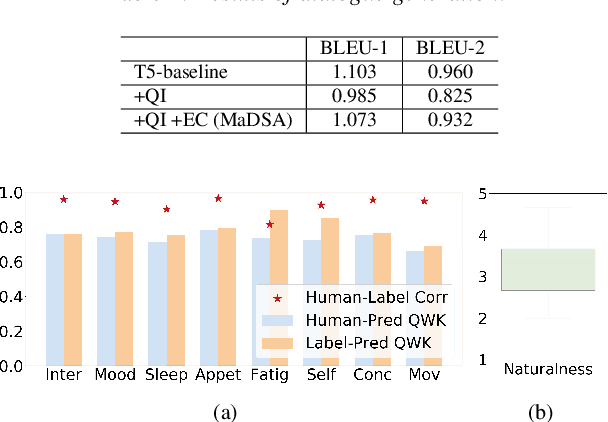Gary Geunbae Lee
Mirror: Multimodal Cognitive Reframing Therapy for Rolling with Resistance
Apr 16, 2025Abstract:Recent studies have explored the use of large language models (LLMs) in psychotherapy; however, text-based cognitive behavioral therapy (CBT) models often struggle with client resistance, which can weaken therapeutic alliance. To address this, we propose a multimodal approach that incorporates nonverbal cues, allowing the AI therapist to better align its responses with the client's negative emotional state. Specifically, we introduce a new synthetic dataset, Multimodal Interactive Rolling with Resistance (Mirror), which is a novel synthetic dataset that pairs client statements with corresponding facial images. Using this dataset, we train baseline Vision-Language Models (VLMs) that can analyze facial cues, infer emotions, and generate empathetic responses to effectively manage resistance. They are then evaluated in terms of both the therapist's counseling skills and the strength of the therapeutic alliance in the presence of client resistance. Our results demonstrate that Mirror significantly enhances the AI therapist's ability to handle resistance, which outperforms existing text-based CBT approaches.
Revisiting Early Detection of Sexual Predators via Turn-level Optimization
Mar 09, 2025Abstract:Online grooming is a severe social threat where sexual predators gradually entrap child victims with subtle and gradual manipulation. Therefore, timely intervention for online grooming is critical for proactive protection. However, previous methods fail to determine the optimal intervention points (i.e., jump to conclusions) as they rely on chat-level risk labels by causing weak supervision of risky utterances. For timely detection, we propose speed control reinforcement learning (SCoRL) (The code and supplementary materials are available at https://github.com/jinmyeongAN/SCoRL), incorporating a practical strategy derived from luring communication theory (LCT). To capture the predator's turn-level entrapment, we use a turn-level risk label based on the LCT. Then, we design a novel speed control reward function that balances the trade-off between speed and accuracy based on turn-level risk label; thus, SCoRL can identify the optimal intervention moment. In addition, we introduce a turn-level metric for precise evaluation, identifying limitations in previously used chat-level metrics. Experimental results show that SCoRL effectively preempted online grooming, offering a more proactive and timely solution. Further analysis reveals that our method enhances performance while intuitively identifying optimal early intervention points.
Teach-to-Reason with Scoring: Self-Explainable Rationale-Driven Multi-Trait Essay Scoring
Feb 28, 2025Abstract:Multi-trait automated essay scoring (AES) systems provide a fine-grained evaluation of an essay's diverse aspects. While they excel in scoring, prior systems fail to explain why specific trait scores are assigned. This lack of transparency leaves instructors and learners unconvinced of the AES outputs, hindering their practical use. To address this, we propose a self-explainable Rationale-Driven Multi-trait automated Essay scoring (RaDME) framework. RaDME leverages the reasoning capabilities of large language models (LLMs) by distilling them into a smaller yet effective scorer. This more manageable student model is optimized to sequentially generate a trait score followed by the corresponding rationale, thereby inherently learning to select a more justifiable score by considering the subsequent rationale during training. Our findings indicate that while LLMs underperform in direct AES tasks, they excel in rationale generation when provided with precise numerical scores. Thus, RaDME integrates the superior reasoning capacities of LLMs into the robust scoring accuracy of an optimized smaller model. Extensive experiments demonstrate that RaDME achieves both accurate and adequate reasoning while supporting high-quality multi-trait scoring, significantly enhancing the transparency of AES.
Retrieval-Augmented Fine-Tuning With Preference Optimization For Visual Program Generation
Feb 23, 2025Abstract:Visual programming languages (VPLs) allow users to create programs through graphical interfaces, which results in easier accessibility and their widespread usage in various domains. To further enhance this accessibility, recent research has focused on generating VPL code from user instructions using large language models (LLMs). Specifically, by employing prompting-based methods, these studies have shown promising results. Nevertheless, such approaches can be less effective for industrial VPLs such as Ladder Diagram (LD). LD is a pivotal language used in industrial automation processes and involves extensive domain-specific configurations, which are difficult to capture in a single prompt. In this work, we demonstrate that training-based methods outperform prompting-based methods for LD generation accuracy, even with smaller backbone models. Building on these findings, we propose a two-stage training strategy to further enhance VPL generation. First, we employ retrieval-augmented fine-tuning to leverage the repetitive use of subroutines commonly seen in industrial VPLs. Second, we apply direct preference optimization (DPO) to further guide the model toward accurate outputs, using systematically generated preference pairs through graph editing operations. Extensive experiments on real-world LD data demonstrate that our approach improves program-level accuracy by over 10% compared to supervised fine-tuning, which highlights its potential to advance industrial automation.
Towards Prompt Generalization: Grammar-aware Cross-Prompt Automated Essay Scoring
Feb 12, 2025Abstract:In automated essay scoring (AES), recent efforts have shifted toward cross-prompt settings that score essays on unseen prompts for practical applicability. However, prior methods trained with essay-score pairs of specific prompts pose challenges in obtaining prompt-generalized essay representation. In this work, we propose a grammar-aware cross-prompt trait scoring (GAPS), which internally captures prompt-independent syntactic aspects to learn generic essay representation. We acquire grammatical error-corrected information in essays via the grammar error correction technique and design the AES model to seamlessly integrate such information. By internally referring to both the corrected and the original essays, the model can focus on generic features during training. Empirical experiments validate our method's generalizability, showing remarkable improvements in prompt-independent and grammar-related traits. Furthermore, GAPS achieves notable QWK gains in the most challenging cross-prompt scenario, highlighting its strength in evaluating unseen prompts.
Multimodal Cognitive Reframing Therapy via Multi-hop Psychotherapeutic Reasoning
Feb 08, 2025Abstract:Previous research has revealed the potential of large language models (LLMs) to support cognitive reframing therapy; however, their focus was primarily on text-based methods, often overlooking the importance of non-verbal evidence crucial in real-life therapy. To alleviate this gap, we extend the textual cognitive reframing to multimodality, incorporating visual clues. Specifically, we present a new dataset called Multi Modal-Cognitive Support Conversation (M2CoSC), which pairs each GPT-4-generated dialogue with an image that reflects the virtual client's facial expressions. To better mirror real psychotherapy, where facial expressions lead to interpreting implicit emotional evidence, we propose a multi-hop psychotherapeutic reasoning approach that explicitly identifies and incorporates subtle evidence. Our comprehensive experiments with both LLMs and vision-language models (VLMs) demonstrate that the VLMs' performance as psychotherapists is significantly improved with the M2CoSC dataset. Furthermore, the multi-hop psychotherapeutic reasoning method enables VLMs to provide more thoughtful and empathetic suggestions, outperforming standard prompting methods.
DyPCL: Dynamic Phoneme-level Contrastive Learning for Dysarthric Speech Recognition
Jan 31, 2025Abstract:Dysarthric speech recognition often suffers from performance degradation due to the intrinsic diversity of dysarthric severity and extrinsic disparity from normal speech. To bridge these gaps, we propose a Dynamic Phoneme-level Contrastive Learning (DyPCL) method, which leads to obtaining invariant representations across diverse speakers. We decompose the speech utterance into phoneme segments for phoneme-level contrastive learning, leveraging dynamic connectionist temporal classification alignment. Unlike prior studies focusing on utterance-level embeddings, our granular learning allows discrimination of subtle parts of speech. In addition, we introduce dynamic curriculum learning, which progressively transitions from easy negative samples to difficult-to-distinguishable negative samples based on phonetic similarity of phoneme. Our approach to training by difficulty levels alleviates the inherent variability of speakers, better identifying challenging speeches. Evaluated on the UASpeech dataset, DyPCL outperforms baseline models, achieving an average 22.10\% relative reduction in word error rate (WER) across the overall dysarthria group.
Multi-Facet Blending for Faceted Query-by-Example Retrieval
Dec 02, 2024Abstract:With the growing demand to fit fine-grained user intents, faceted query-by-example (QBE), which retrieves similar documents conditioned on specific facets, has gained recent attention. However, prior approaches mainly depend on document-level comparisons using basic indicators like citations due to the lack of facet-level relevance datasets; yet, this limits their use to citation-based domains and fails to capture the intricacies of facet constraints. In this paper, we propose a multi-facet blending (FaBle) augmentation method, which exploits modularity by decomposing and recomposing to explicitly synthesize facet-specific training sets. We automatically decompose documents into facet units and generate (ir)relevant pairs by leveraging LLMs' intrinsic distinguishing capabilities; then, dynamically recomposing the units leads to facet-wise relevance-informed document pairs. Our modularization eliminates the need for pre-defined facet knowledge or labels. Further, to prove the FaBle's efficacy in a new domain beyond citation-based scientific paper retrieval, we release a benchmark dataset for educational exam item QBE. FaBle augmentation on 1K documents remarkably assists training in obtaining facet conditional embeddings.
Guide-to-Explain for Controllable Summarization
Nov 19, 2024



Abstract:Recently, large language models (LLMs) have demonstrated remarkable performance in abstractive summarization tasks. However, controllable summarization with LLMs remains underexplored, limiting their ability to generate summaries that align with specific user preferences. In this paper, we first investigate the capability of LLMs to control diverse attributes, revealing that they encounter greater challenges with numerical attributes, such as length and extractiveness, compared to linguistic attributes. To address this challenge, we propose a guide-to-explain framework (GTE) for controllable summarization. Our GTE framework enables the model to identify misaligned attributes in the initial draft and guides it in explaining errors in the previous output. Based on this reflection, the model generates a well-adjusted summary. As a result, by allowing the model to reflect on its misalignment, we generate summaries that satisfy the desired attributes in surprisingly fewer iterations than other iterative methods solely using LLMs.
Multi-aspect Depression Severity Assessment via Inductive Dialogue System
Oct 29, 2024



Abstract:With the advancement of chatbots and the growing demand for automatic depression detection, identifying depression in patient conversations has gained more attention. However, prior methods often assess depression in a binary way or only a single score without diverse feedback and lack focus on enhancing dialogue responses. In this paper, we present a novel task of multi-aspect depression severity assessment via an inductive dialogue system (MaDSA), evaluating a patient's depression level on multiple criteria by incorporating an assessment-aided response generation. Further, we propose a foundational system for MaDSA, which induces psychological dialogue responses with an auxiliary emotion classification task within a hierarchical severity assessment structure. We synthesize the conversational dataset annotated with eight aspects of depression severity alongside emotion labels, proven robust via human evaluations. Experimental results show potential for our preliminary work on MaDSA.
 Add to Chrome
Add to Chrome Add to Firefox
Add to Firefox Add to Edge
Add to Edge